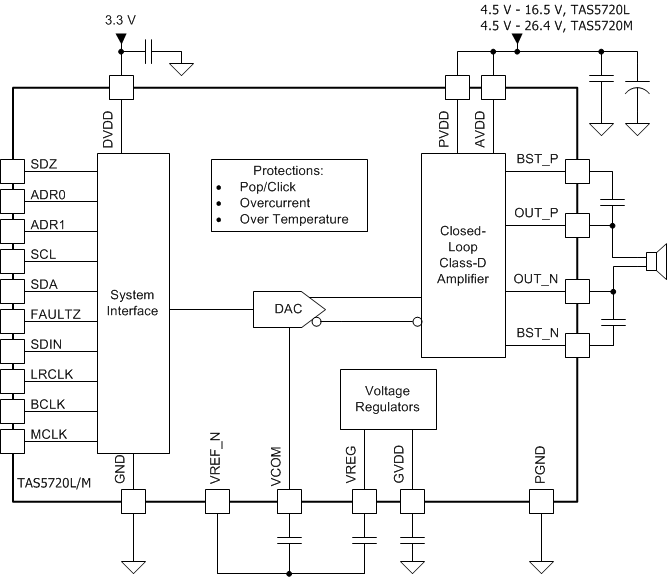SLOS903B May 2015 – February 2016 TAS5720L , TAS5720M
PRODUCTION DATA.
- 1 Features
- 2 Applications
- 3 Description
- 4 Revision History
- 5 Pin Configuration and Functions
- 6 Specifications
- 7 Detailed Description
- 8 Applications and Implementation
- 9 Power Supply Recommendations
- 10Layout
- 11Device and Documentation Support
- 12Mechanical, Packaging, and Orderable Information
Package Options
Mechanical Data (Package|Pins)
- RSM|32
Thermal pad, mechanical data (Package|Pins)
Orderable Information
1 Features
- Mono Class-D Amplifier
- 20 W at 0.15% THD Continuous into
19 V / 4 Ω
- 20 W at 0.15% THD Continuous into
- TDM Audio Input
- Up to 8 Channels (32-bit, 48 kHz)
- I2C Control With 8 Selectable I2C Address
- Power Supplies
- Power Amplifier: 4.5 V to 16.5 V, TAS5720L
- Power Amplifier: 4.5 V to 26.4 V, TAS5720M
- Digital I/O: 3.3 V
- Protection: Thermal and Short-Circuit
- Package: 4 mm × 4 mm, 32-pin VQFN
2 Applications
- Sub Woofers
- Boom Boxes
- Bar Speakers
- Surround Sound Systems
3 Description
The TAS5720x device is a high-efficiency mono Class-D audio power amplifier optimized for high transient power capability to use the dynamic power headroom of small loudspeakers. The device is capable of delivering more than 15 W continuously into a 4-Ω speaker.
The digital time division multiplexed (TDM) interface enables up to eight devices to share the same bus.
The TAS5720x device is available in a 32-pin,
4 mm × 4 mm, VQFN package for a compact PCB footprint.
Device Information(1)
| PART NUMBER | PACKAGE | BODY SIZE (NOM) |
|---|---|---|
| TAS5720L | VQFN (32) | 4.00 mm × 4.00 mm |
| TAS5720M |
- For all available packages, see the orderable addendum at the end of the datasheet.
Simplified Schematic
